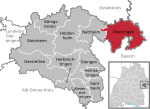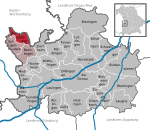Neresheim
OstalbkreisStuttgart region geography stubsTowns in Baden-Württemberg

Neresheim is a town in the Ostalbkreis district, in Baden-Württemberg, Germany. It is situated 16 kilometres (9.9 mi) northeast of Heidenheim, and 20 kilometres (12 mi) southeast of Aalen. It's the home of the Neresheim Abbey, which still hosts monks, was Reichsfrei until the German Mediatisation and was built by Balthasar Neumann. Another notable touristic attraction is the heritage railway Härtsfeldbahn. Neresheim is listed on the Arc de Triomphe in Paris, France, along with 95 other sites of battles won by the French army.
Excerpt from the Wikipedia article Neresheim (License: CC BY-SA 3.0, Authors, Images).Neresheim
Obere Gasse,
Geographical coordinates (GPS) Address Nearby Places Show on map
Geographical coordinates (GPS)
| Latitude | Longitude |
|---|---|
| N 48.754166666667 ° | E 10.334444444444 ° |
Address
Mariä Himmelfahrt
Obere Gasse 1
73450
Baden-Württemberg, Germany
Open on Google Maps











